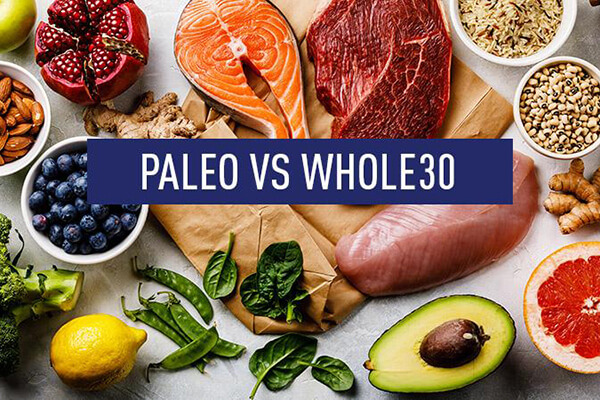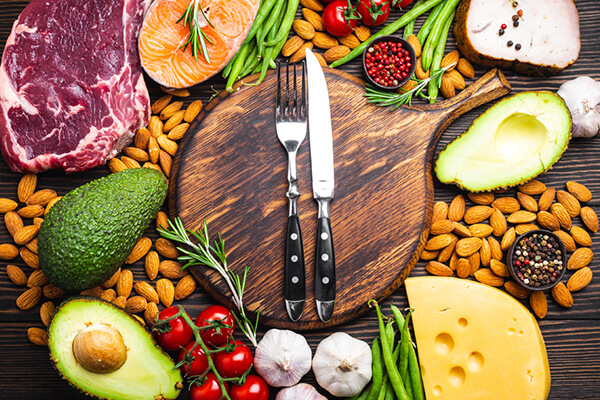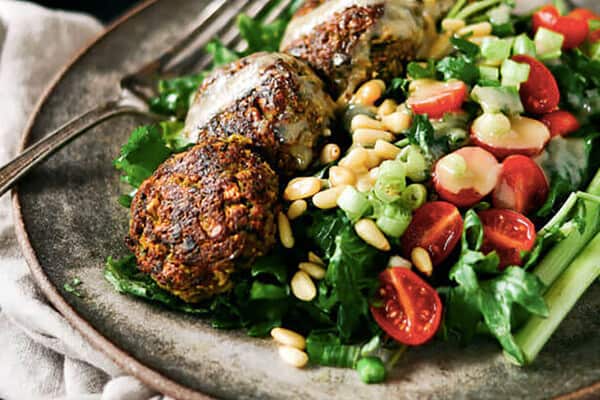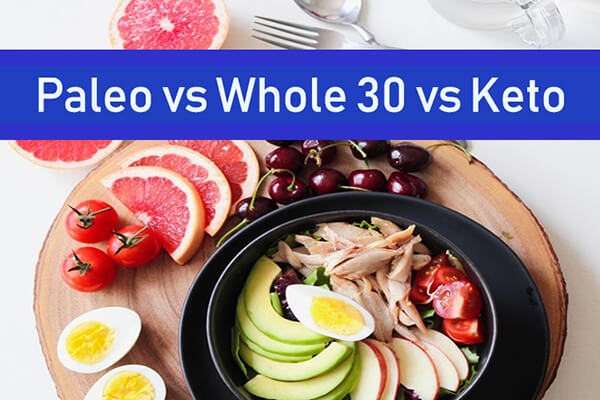Paleo and Whole30

Are you stuck between choosing Whole30 and Paleo? Paleo and Whole30 diets are two common dieting programs. Both whole30 and paleo encourage people to eliminate processed and unhealthy foods. They both aim to enhance your overall health and help you lose some weight. Because of the wide range of health benefits they offer and the similarities between them, many have been wondering which is best between them.
Paleo diet vs. Whole30 which should I choose? What is the difference between paleo and whole30? In this article, we will walk you through what paleo and whole30 diets are, their similarities, and the differences between them.
Paleo Overview

The paleo diet is an elimination diet that encourages participants to eat foods that our Paleolithic ancestors consumed before the farming era started 10,000 years ago. The diet allows for any food that was available to hunger gatherers and convenience foods, modernized grains, and dairy are out of the equation.
While on this diet, the majority of your meals will consist of veggies and meat with occasional sweet potatoes. The diet is based on minimally processed, whole foods, and it promises to help you lose some weight. The paleo diet also has a long list of foods to eat and those you should avoid. If you want to stay true to this course, you have to abide by the rules of the game.
Paleo Approved Foods to Eat
Here is a list of foods that you can eat while on the paleo diet:
- Fish
- Meat
- Fruits
- Eggs
- Veggies
- Herbs
- Seeds
- Nuts
- Spices
- Vegetable oils such as extra-virgin olive oil and coconut oil
- Dark chocolate and wine (in minimal amounts)
- Natural sweeteners such as coconut sugar, honey, and maple syrup
- Sweet potatoes
Paleo Foods to Avoid
Like every other diet plan, paleo also has a list of foods you should avoid. Here is a list of foods you are not allowed to eat while on this program:
- Processed foods
- Artificial sweeteners
- Added sugar
- Legumes including beans, peanuts, and soy
- Grains
- Trans fats
- Some vegetable oils such as safflower oil, sunflower oil, and soybean oil.
- Alcohol
- Dairy products
- White potatoes
Because of the structure of paleo, it is naturally dairy-free, gluten-free, peanut-free, and soy-free, and this makes it a great option for people with common allergies and sensitivities. Furthermore, the program encourages you to choose grass-fed and organic products whenever you have the option to choose.
In summary, the paleo diet encourages people to eat foods that our hunter-gatherer ancestors might have eaten. By sticking to the rules, the program promises to help you lose weight and prevent some modern, common health conditions and diseases.
Whole Overview

The Whole30 diet is a 30-day program designed to eliminate food groups intended to alter your relationship with food. The program aims to reset your metabolism while reshaping your relationship with food. It is designed to reset your health by introducing you to healthy and whole foods, eliminating all junk and processed food from your diet.
The whole30 program encourages people to stick to whole foods, and it promises many health benefits including weight loss without counting calories. Whole30 promises to enhance your sleep, boost your energy levels, help you identify food intolerances, boost your athletic performance, and reduce cravings.
The program lasts for 30 days. During these 30 days, there is a long list of foods and beverages you are not allowed to eat. However, you will gradually reintroduce the eliminated foods after the 30-day period. With this approach, you would be able to know which food groups are causing you problems. During the reintroduction, if your body reacts to any food, it means that food is not good for you. By helping you identify the foods causing you discomfort or making you feel bad, you would be able to eliminate them for good.
Whole30 Approved Foods
Here is a list of the foods whole30 allows you to eat within the duration of the program:
- Fish
- Poultry
- Meat
- Eggs
- Vegetables
- Fruits
- Seeds
- Nuts
- Some fasts such as ghee, clarified butter, duck fat, olive oil, avocado oil, and plant oils
- Potatoes
Foods to Avoid on Whole30
Here is a list of foods that you should not consume within the 30-day period of the program:
- Added sugars
- Processed additives
- Artificial sweeteners
- Legumes
- Soy
- Pulses
- Dairy
- Grains
- Alcohol
- Junk foods, baked goods, and treats
- Ingredients such as sulfites, MSG, and carrageenan
The Whole30 program also comes with additional rules such as not weighing yourself in the course of the program. You are also not allowed to take body measurements. Rather, your focus should be on non-scale victories that enhance your overall health and wellbeing.
In summary, this program is aimed at helping you to identify food intolerances and create a good relationship with food. It also promises enhanced overall health and wellbeing, including weight loss. The duration of the program is one month, and you have to eat only whole foods for that period.
Paleo vs. Whole30 | Difference between Paleo and Whole30

Whole and paleo tend to differ greatly on their beliefs, foundations, and long-term goals. The whole30 program is a short-term program that lasts for only 30 days whereas paleo is more like a long-term, lifestyle approach to a healthy life.
The whole30 program eliminates certain food groups for 30 days while paleo eliminates non-paleo-approved foods for the foreseeable future. The philosophy on which paleo is built is also different from that of Whole30. The creators of paleo believe there is not much change in our DNA since the Paleolithic era, so there should not be much change in our diet either.
Paleo also encourages people to choose grass-fed and organic products when possible while Whole30 said it is not necessary. The philosophy on which whole30 is created is that junk foods are responsible for our health issues and eating addictions. Eliminating those food groups will help reset your system and make it easy for you to identify the foods causing problems in your body. This makes Whole30 more centered around helping you to build a better relationship with food and your body.
| Differences Between Paleo and Whole30 | ||
| S/N | Paleo | Whole30 |
| 1 | Lifestyle approach | 30-day period |
| 2 | Caveman diet | Elimination diet |
| 3 | No white potatoes | Allows potatoes |
| 4 | Allows natural sweeteners | No sugars |
| 5 | Grass-fed meats | No artificial sweeteners |
| 6 | Organic produce | No “treat foods” |
| 7 | Allows treat foods | No checking your weight |
| 8 | Allows some alcohol | No alcohol of any form |
Paleo Diet vs. Whole30 | Similarities

Whole30 and paleo have some similarities in their health effects and restrictions. Here are some of the similarities between paleo and whole30:
They Both Eliminate Similar Food Groups
There is plenty of nutrient-dense veggies and fruits in Whole30 and paleo diets. Both diets eliminate certain food groups such as dairy, legumes, and grains that provide a wide range of beneficial nutrients like protein, carbohydrates, fiber, iron, selenium, magnesium, and several B vitamins. Eliminating these foods will reduce your intake of carbs and increase your protein consumption, as most of your diets will contain high amounts of protein.
They Both Promise to Help You Lose Weight
Paleo and whole30 have a restrictive nature that causes calorie deficiency, which helps you to lose weight without counting calories or measuring portions. Both diets are also very rich in fibrous veggies and fruits, which can reduce cravings and hunger while making you feel full most time. All these factors contribute to weight loss.
Furthermore, by eliminating legumes, dairy, and grains, these diets are higher in protein and lower in carbs than the average diet. Protein-rich diets are also known to reduce appetite naturally, and they help you lose fat while maintaining muscle mass, which is vital weight-loss factors.
They Both Provide Health Benefits
Whole30 and paleo provide a wide range of health benefits. That is because they are very rich in veggies and fruits, and they eliminate unhealthy junk and highly processed foods. According to studies, the paleo diet can reduce inflammation, enhance insulin sensitivity, and reduce blood sugar levels, which are all factors that can reduce your chances of type 2 diabetes.
Both diets can also reduce your chances of heart disease, including LDL cholesterol levels, triglycerides, and blood pressure. The Whole30 diet also provides many health benefits that are similar to that of paleo. They will help reset your body system and boost the nutrient absorption capabilities of your body.
Conclusion
Both paleo and whole30 have proven to be very effective diet programs. When it comes to weight loss, you can rely on both of them, as they can help enhance your body composition and help you lose weight. They also enhance overall health, reduce the risk of diet-related health issues, and reduce inflammation. There is no magic secret to the Whole30 and paleo diet when it comes to enhancing your nutrition and losing weight. They both have a set of rules that you need to follow in order to enjoy the benefits they offer. Now that you know what they are and the differences between them, choosing the right diet plan for your needs should no longer be an issue.






